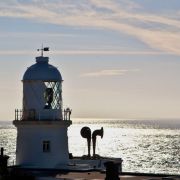Pendeen Fogou
'Pendene Vowe, a holl or deepe vaute in the grounde, wherinto the sea floweth at high water, very farr under the earth: Manie have attempted, but none effected, the search of the depth of it'.
John Norden's early seventeenth century description of Pendeen Fogou, or Vau, contains a delicious sense of the mystery associated with this ancient monument. Although it is now known that Pendeen Fogou is around seventeen meters long, stopping several miles short of the sea, it remains one of the most enticing of these underground caves, the purpose of which remains unclear. Pendeen Fogou dates back around three thousand years, to the late Bronze Age, when it was possibly part of a larger settlement. Many historians think that there was a cliff castle where Pendeen lighthouse is today and that the fogou may have been used in conjunction with it as a place to perform ceremonies and rituals. The name 'Pendeen', translates as 'headland of the castle'.
Pendeen Fougou is set in a hedge in the farmyard of Pendeen Manor Farm, the birthplace of William Borlase, who is considered the father of Cornish archaeology. After about seven meters the main passage slopes steeply and the roof slabs are stepped, like the underside of a staircase. Two smaller passages branch off at the end of the main passage, whose roof has partially fallen in. There are numerous legends associated with Pendeen Fogou, many of which focus on a woman in white, whose appearance at the entrance of the fougou signals imminent death for those who are unfortunate enough to clap eyes on her. The fougou is near the coast road as it heads out of St Just towards Zennor. It can be visited with permission from the farm owners.





